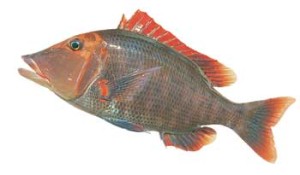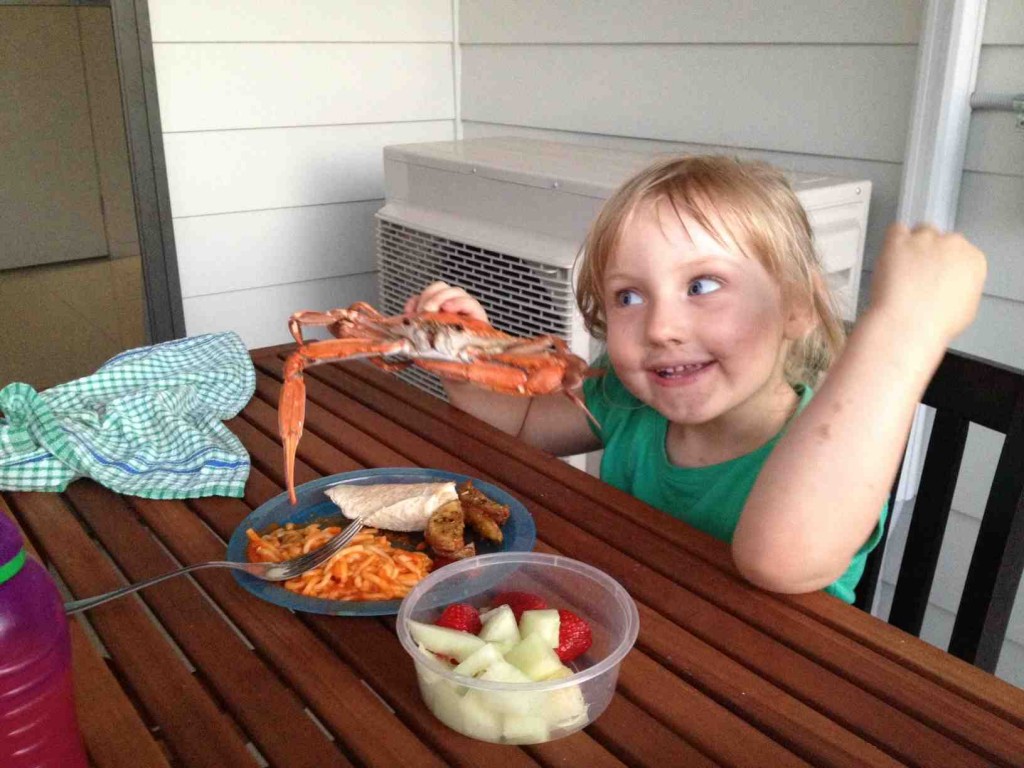A Friday evening dinner of red throat emperor fillets, salad and sweet potato wedges. All baked because I ran out of gas for the grill. Fish temped to 130F.
Tag Archives: Seafood
Bad fish: Australian mother and daughter likely died of scombroid food poisoning in Bali
Autopsies have found scombroid food poisoning likely caused the deaths of Noelene and Yvana Bischoff in Bali last month.
Their family has been told forensic pathologists, who conducted autopsies on Noelene Bischoff, 54, and her 14-year-old daughter Yvana, had found they died from a  combination of food poisoning and existing medical conditions after they ate fish at a Bali restaurant in early January.
combination of food poisoning and existing medical conditions after they ate fish at a Bali restaurant in early January.
Malcolm Bischoff, Noelene’s brother, said it appeared they both suffered from food poisoning that, coupled with their asthma and, in Noelene’s case, migraine medication had formed a fatal cocktail. “We were happy it wasn’t foul play because that would be disgusting,” Mr Bischoff said.
Scombroid food poisoning can result from eating spoiled fish, meaning the restaurant’s preparation could have made no difference, Mr Bischoff said.
10 sick; ciguatera poisoning in Spain
The epidemiology and prevention of the Directorate General of Public Health of the Canary Government investigates the emergence of 10 cases of people who might be 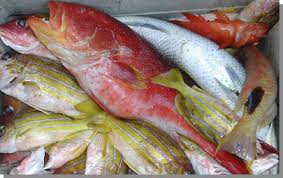 affected by ciguatera poisoning related to consumption of fish in San Bartolomé.
affected by ciguatera poisoning related to consumption of fish in San Bartolomé.
None has required hospital admission, although some were treated in emergency departments.
An investigation by the inspection services of the Department of Health has allowed Lanzarote locate “within hours” fish purchased at a shop in San Bartolomé.
This lunch is for you, Braunwynn
After our regular Saturday morning hockey skating session, where tales of 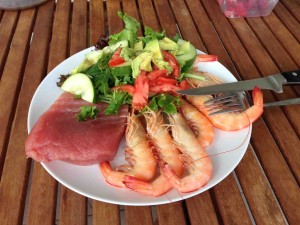 this Canadian girl who could out-skate all the boys still circulate, we had a lunch of salad, tiger shrimp and sashimi tuna (mine was grilled).
this Canadian girl who could out-skate all the boys still circulate, we had a lunch of salad, tiger shrimp and sashimi tuna (mine was grilled).
Kansas, seafood and heat; tongue-eating louse found in supermarket fish freaks out unsuspecting customer
When I think Kansas, I think seafood.
Or not.
Mussels from Prince Edward Island (that’s in Canada) in Kansas. Locavores rejoice.
I can’t wait to get back to Brisbane. Cooler times are on the way, and that means better fish. This was part of the weekly mailer from the local fish  monger for what’s available:
monger for what’s available:
• live mudcrabs in Friday – call us to have one cooked
• whole fresh Rainbow Trout in today
• fresh green Tiger Prawns straight from Moreton Bay
• cooked and green Moreton Bay Bugs
• fresh fillet – barramundi, gold band snapper, Tassie & NZ salmon
• ocean trout
• Hervey Bay 1/2 shell scallops
• Coffin Bay oysters
• fresh local squid (apparently delicious stuffed with pork mince, need to try that).
Seafood is cooked in our house, for a variety of reasons, and perhaps should be at the home of Rick Beattie in Belfast, who found a large parasitic louse in the mouth of his sea bass dinner.
Beattie, who had purchased the fish at a Tesco location in Belfast, was promised a refund after he brought the incident to the grocery’s attention. “It was like something from a horror film,” Beattie said, according to SWNS.com. “I’m sure other Tesco customers would be interested.”
The parasite, known as the tongue-eating louse or Cymothoa exigua, enters a fish through its gills and attaches itself to the creature’s tongue. Once in place, the louse destroys the fish’s tongue, replacing it. The louse does not  appear to hurt the fish in any other way. They’re not believed to be dangerous to humans, although they can bite if picked up alive.
appear to hurt the fish in any other way. They’re not believed to be dangerous to humans, although they can bite if picked up alive.
A Tesco spokesman stressed that the company wishes to undertake an “an urgent and thorough investigation” of the fish’s supplier, Yahoo writes. “We have very high standards for food quality,” he said. “[B]oth we and our suppliers have robust checks in place to ensure that our food meets those standards.” It has asked Beattie to provide the fish in question to aid the investigation.
Seafood is cooked in our house
“I’ve had food poisoning multiple times as a Michelin Inspector… and I think each time seafood was the culprit.” — An anonymous Michelin Guide inspector in San Francisco on the dangers of their job.
My lunch, Sydney airport. We had a chat about temperature.
Optimum cooking conditions for shrimp and Atlantic salmon
Sorenne and I dismembered a muddy for dinner the other day (after humanely anesthetizing it in the freezer for an hour) before cooking and devouring muddy along with some bay bugs.
Daughter Courtlynn and I have been e-mailing about the virtues of Australian 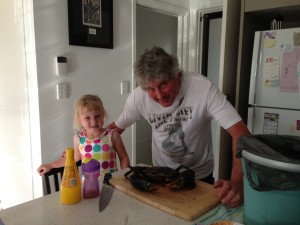 crabs versus the sweetness of the stone crabs we had in Florida.
crabs versus the sweetness of the stone crabs we had in Florida.
Not bad for a couple of landlubbers.
But whatever your nautical preference, cook it safe.
The following abstract was published in the current Journal of Food Science, focusing on safe shrimp and salmon preparation. The problem is, how is an extra jumbo shrimp defined? Maybe it’s in the paper, but why not just use a tip-sensitive digital thermometer to account for subjective variations?
Stick it in. I do
Optimum cooking conditions for shrimp and atlantic salmon
Journal of Food Science
Lauren Brookmire, P. Mallikarjunan, M. Jahncke, R. Grisso
The quality and safety of a cooked food product depends on many variables, including the cooking method and time–temperature combinations employed. The overall heating profile of the food can be useful in predicting the quality changes and microbial inactivation occurring during cooking. Mathematical  modeling can be used to attain the complex heating profile of a food product during cooking. Studies were performed to monitor the product heating profile during the baking and boiling of shrimp and the baking and pan-frying of salmon. Product color, texture, moisture content, mass loss, and pressed juice were evaluated during the cooking processes as the products reached the internal temperature recommended by the FDA. Studies were also performed on the inactivation of Salmonella cocktails in shrimp and salmon. To effectively predict inactivation during cooking, the Bigelow, Fermi distribution, and Weibull distribution models were applied to the Salmonella thermal inactivation data. Minimum cooking temperatures necessary to destroy Salmonella in shrimp and salmon were determined. The heating profiles of the 2 products were modeled using the finite difference method. Temperature data directly from the modeled heating profiles were then used in the kinetic modeling of quality change and Salmonella inactivation during cooking. The optimum cooking times for a 3-log reduction of Salmonella and maintaining 95% of quality attributes are 100, 233, 159, 378, 1132, and 399 s for boiling extra jumbo shrimp, baking extra jumbo shrimp, boiling colossal shrimp, baking colossal shrimp, baking Atlantic salmon, and pan frying Atlantic Salmon, respectively.
modeling can be used to attain the complex heating profile of a food product during cooking. Studies were performed to monitor the product heating profile during the baking and boiling of shrimp and the baking and pan-frying of salmon. Product color, texture, moisture content, mass loss, and pressed juice were evaluated during the cooking processes as the products reached the internal temperature recommended by the FDA. Studies were also performed on the inactivation of Salmonella cocktails in shrimp and salmon. To effectively predict inactivation during cooking, the Bigelow, Fermi distribution, and Weibull distribution models were applied to the Salmonella thermal inactivation data. Minimum cooking temperatures necessary to destroy Salmonella in shrimp and salmon were determined. The heating profiles of the 2 products were modeled using the finite difference method. Temperature data directly from the modeled heating profiles were then used in the kinetic modeling of quality change and Salmonella inactivation during cooking. The optimum cooking times for a 3-log reduction of Salmonella and maintaining 95% of quality attributes are 100, 233, 159, 378, 1132, and 399 s for boiling extra jumbo shrimp, baking extra jumbo shrimp, boiling colossal shrimp, baking colossal shrimp, baking Atlantic salmon, and pan frying Atlantic Salmon, respectively.
Another Tuesday night dinner — seafood edition
I scored some clearance seafood yesterday at the shops – new shipments coming in. Dinner featured blue swimmer crab (they’re blue before they’re cooked) and bay bugs, with strawberries, honeydew melon, herbed potato wedges, and a salad of Romaine lettuce, spring snap peas and Lebanese cucumbers
Asian culture, food regs collide in Virginia?
The New York Times reports that in the rear of the Great Wall supermarket in Falls Church, Virginia, customers linger over razor clams, frozen conch and baby smelt arrayed at the fish counter. Crabs clamber over the ice. Below, sea bass circle in glass tanks. A girl in a stroller, eye level with a school of tilapia, giggles in delight.
But other tanks are empty. The bullfrogs, turtles and eels that Northern Virginia’s booming Asian population used to buy at the counter and take home to cook are nowhere to be found, seized last 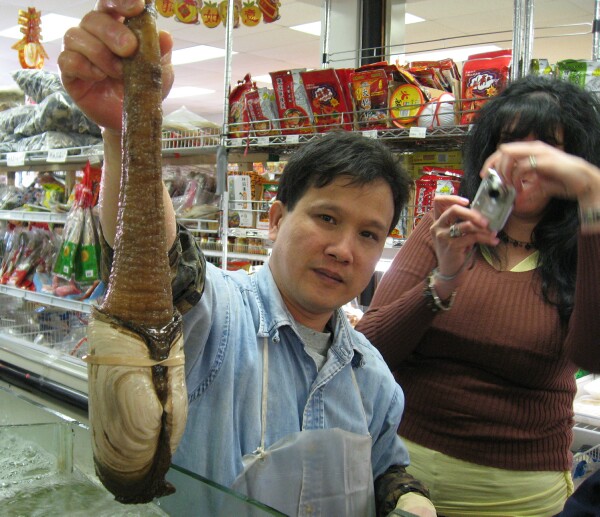 year by state agents who leveled criminal charges against two managers of the store accusing them of illegally selling wildlife.
year by state agents who leveled criminal charges against two managers of the store accusing them of illegally selling wildlife.
The case, which is scheduled to go to trial in June, has put culinary traditions of Asian immigrants into conflict with state laws, illustrating what some see as a cultural fault line in the changing population of Northern Virginia. Asians make up 13.6 percent of the population of four Northern Virginia counties.
Lawyers for the store managers say that the law governing sales of live fish and other animals has not been updated to reflect advances in aquaculture, and that it is tilted against immigrants with unfamiliar cuisines and customs. In a court filing, they argue that the case “seems to be about the tyranny of the majority.”
It is clear that Kai Wei Jin, one of the managers charged, is unhappy about being in the middle of a criminal case. Mr. Jin, 25, fiddled uncomfortably with his phone during an interview, saying he just wanted to satisfy his customers.
“We’re not trying to break the law,” he said. “We just want to do business, and just support the culture.”
Lee Walker, a spokesman for the Virginia Department of Game and Inland Fisheries, said that the laws were necessary to protect wildlife, and that charges were leveled only after a warning went unheeded.
“We really try to educate folks about the regulations before we ever try to bring charges,” he said. “In this case, every attempt was made to educate about what’s legal. And, unfortunately, action was not taken.”
The case arose early last year after what prosecutors called a “concerned citizen” made a report of illegal sales. Officials went to the store several times and bought red-eared slider turtles and largemouth bass, which they said was labeled “mainland rockfish.” They returned last April, seizing turtles, eels, bullfrogs and crayfish, and delivered a warning, prosecutors said.
When officials returned and found largemouth bass still for sale, they said, they sought charges against the managers. Both were indicted on four felony counts, but the prosecutor later agreed to reduce the charges to misdemeanors, which carry potential penalties of jail time and fines of up to $2,500.
Some of the species fall under a broad category of wildlife that cannot be bought or sold, while sales of largemouth bass are forbidden because it is a native game fish. Crayfish can be sold, but the store 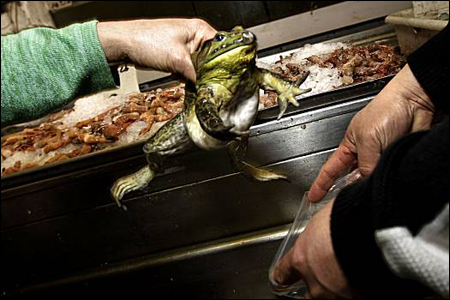 lacked permits, according to prosecutors’ court filings.
lacked permits, according to prosecutors’ court filings.
Lawyers for the store managers say that categorizing the fish and other creatures as wildlife does not make sense, because they were farm-raised for eating.
Receipts filed with court motions show, for example, that some of the turtles were raised in Oklahoma. The bullfrogs were shipped from the Dominican Republic. The bass and some eels came from a Pennsylvania fish farm.
A Great Wall store in neighboring Maryland makes for a study in contrast. The fish counter there has many of the creatures that have vanished from the Virginia store. Turtles labeled “farm-raised” paddle in one tank, selling for $9.99 per pound. At the counter, mesh bags bulge with live bullfrogs for $5.99 a pound.
Love letters from FDA: fishy fish, bad buns
It’s like a game show: This Week in Warning Letters from FDA.
Take your chances, make mistakes, let the U.S. Food and Drug Administration lay out your food failings in public view.
 Seafood was a repeat offender, and some others:
Seafood was a repeat offender, and some others:
• General Tuna Corporation, based in the Philippines, cited for having a HACCP plan that really sucked;
• Chung’s and Son Company of Temple Hills, Maryland, cited for having a HACCP plan that really sucked, your vegetable and shrimp egg roll is adulterated, in that they have been prepared, packed, or held under insanitary conditions whereby they may have been rendered injurious to health;
• Custom Seafood Services Inc. of Seattle, Washington, cited for having a HACCP plan that really sucked, your Dungeness crab sections and King crab legs and claws are adulterated;
• Concept Asia Food Service, another Seattle fish processor with a lousy HACCP plan,
your sushi roll products, including the salmon roll, eel roll, tai roll, imitation crab roll, and tuna roll, are adulterated
• Sugar Bakers, Inc. of Catonsville, Maryland, you have lousy handwashing trash all over the place, and poor storage choices;
• Panaderia El Angel of Arlington, Washington, a Hispanic bakery, you have serious violations of Good Manufacturing Practices, your products are all adulterated;
• K-Brand Farms of Woodridge, New York, you have serious violations of the Prevention of Salmonella Enteritidis (SE) in Shell Eggs During Production, Storage, and Transportation regulation (the shell egg regulation), your shell eggs are adulterated; and,
• Societe Fromagere de Bouvron of Bouvron, France, you produce cheese with substandard equipment.
Join us again next week.
Your moment of homage, from Second City TV in 1981,
and, something else.

